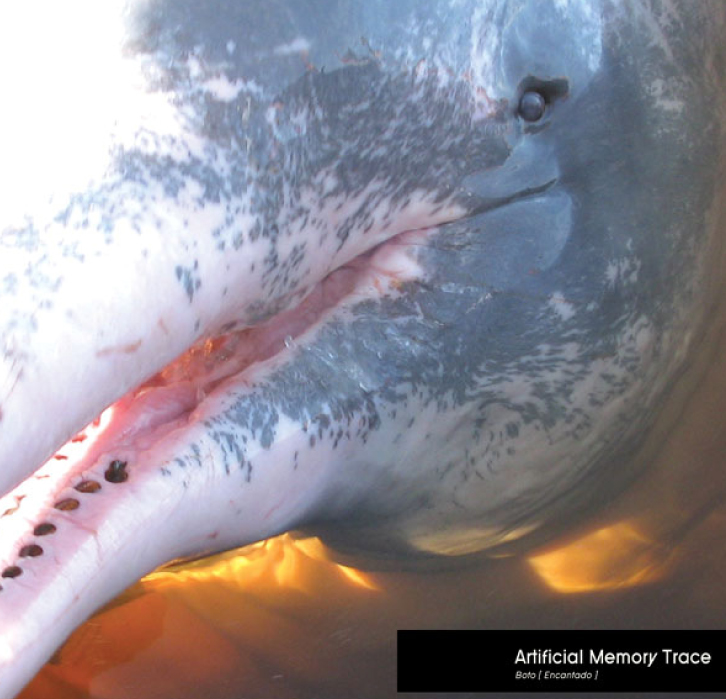Boto [Encantado]. ARTIFICIAL MEMORY TRACE -Slavek Kwi-
(Iniitu 2011)
Slavek Kwi, aka artificial memory trace, has released this album on ini itu, a specialist vinyl label with a catalogue of some excellent work across several idioms. Boto [Encantado] will be of great interest to the growing band of artists and composers who work with field recordings, especially in wilderness environments and more specifically with the animal world.
The album, explores, the sounds of two river dolphins, the Boto or Amazonian River or Pink Dolphin and the Tucuxi, a smaller estuary dolphin. A complete orchestra of sounds, from frogs, to insects (above and below the water), fish, bats, humans and their machines, can be heard accompanying the main characters. This is of course just what you’d expect in a jungly place like the Amazon – forgive me if I’m misrepresenting the place but I’ve only ever seen it on the telly and listened to albums like this.
The source sounds are given further interest by means of various transformations, set in the context of a composed work. The album cover invites you to ignore the accompanying information sheet. That’s like asking a child ‘not to go in that room’, so I immediately opened out the sheet. Unfortunately it’s been printed as a mirror image so I found myself doing a like Harry Potter impersonation, deciphering the text with a mirror. We are offered a full description of the individual sounds along with full details of the various processes carried out on each sound, most useful in the end as the album certainly invites a degree of detective work. Finally, the kit list reveals a formidable array of high end recording devices and microphones (am I the only field recordist on the planet without a Sound Devices?).
So, dolphins – who doesn’t love them? I always did, though I wavered when I found out how vicious these brutes can be if you’re at the wrong end of the food chain. But with most of us humans they’ve always drawn out some measure of empathy. We always feel that they’re communicating with us, in an absolute sense, requiring no language or other physical mediation. And river dolphins have the added mystery of being able to metamorphose into creatures which can seduce us (and worse!), like the Silkies of Scottish and other Northern European mythologies.
Communication or not, it’s the physicality of the dolphins’ ‘language’ which holds this album together. Throughout the work, Kwi has very cleverly managed to make the most of what I’d consider to be difficult sounds. The clicks and snorts tell us that we’re in the presence of a living creature, but we’d soon tire (at least I would) of a whole album of such sounds. So the artist has stretched and filtered the sounds, drawing out some added interest from their original morphologies, though I’d have welcomed even further experimentation with the degree of timestretching. Iterations become hard to distinguish from short loops, so we have the impression of listening to the randomness of a natural sound world.
Various water clues, the cries and calls of river creatures, fill out the background more generally. This, the combination of different sound sources, is of course a primary compositional technique. Here, Kwi works with contrast to good effect, relying at times on the backcloth of jungly insect sounds, at other times on the simple juxtaposition of a few distinctive brighter timbres, a hissy background, some crackles, a hint of water bubbles. As a device to add interest to the pace and flow of the work, sharp cuts keep us alert, pulling us out of any temptation to succumb to an ambient soundscape in the widest sense of the term.
I’ve stressed that the main problem faced by an the artist who uses restricted resources, despite transformations and despite the added value of conceptual depth afforded by having all sounds taken from a fairly tight location, is that they can lose interest quite rapidly. Where I think that Slavek Kwi has been most astute is in his exploitation of the mimetic attributes of his primary source material. I knew that throughout this work there was a very intelligent mammal ‘there’, always up to something, and I wanted to figure out, or at least it seemed as if I should be trying to figure out what it was he was up to. It seems to me that the artist had this in mind throughout, which would of course be psychologically legitimate.
In summary, Boto [Encantado] is a very well assembled and original work. In his gestural and event led approaches to composition, the artist make best use of an engaging variety of natural localised sound sources, without relying on more broadbrush techniques such as dense polyphony and complex counterpoint. I’d add finally that it gains also from holding a measure of value as a work of documentary art.
-Caity Kerr


